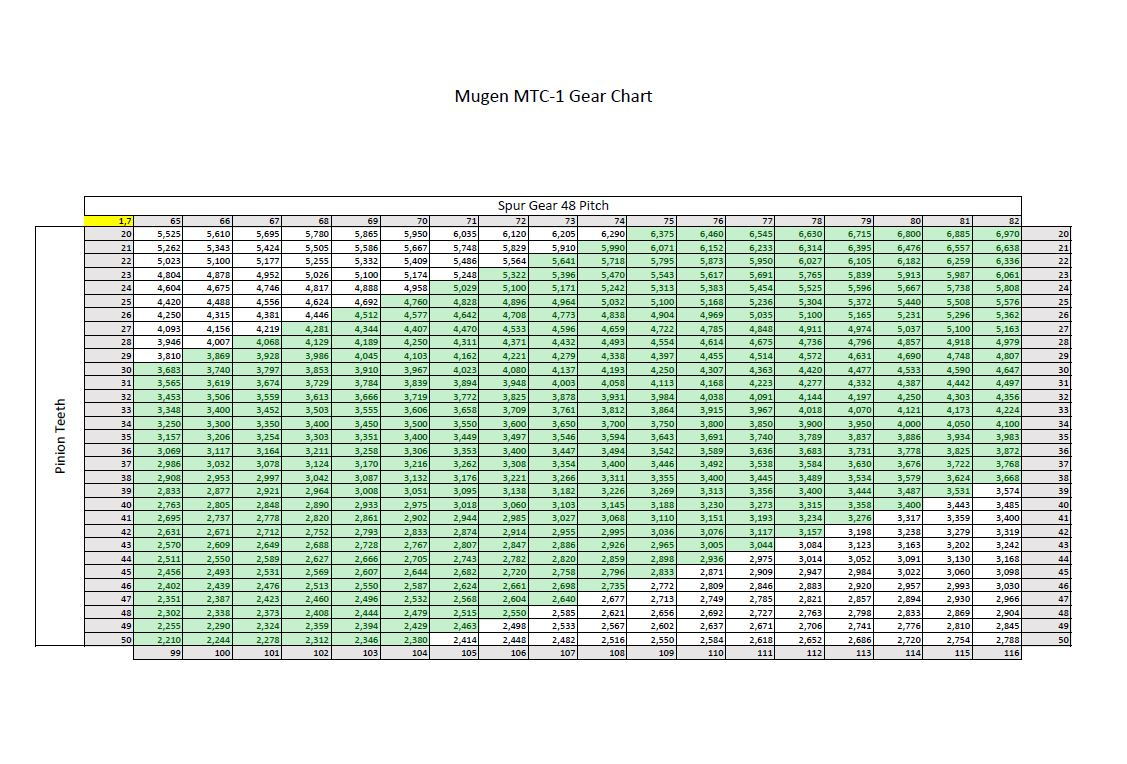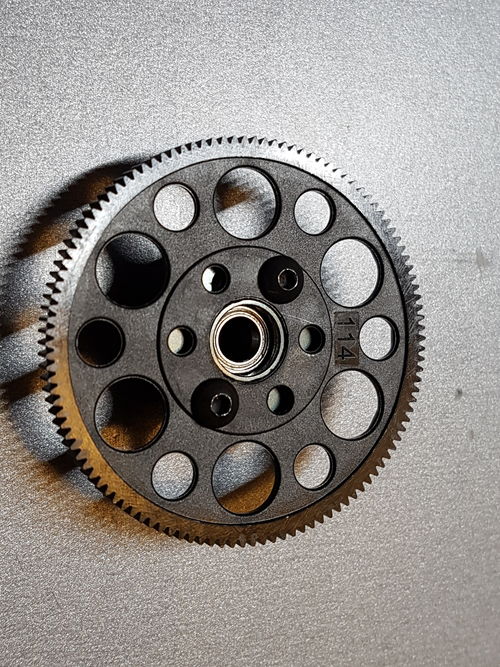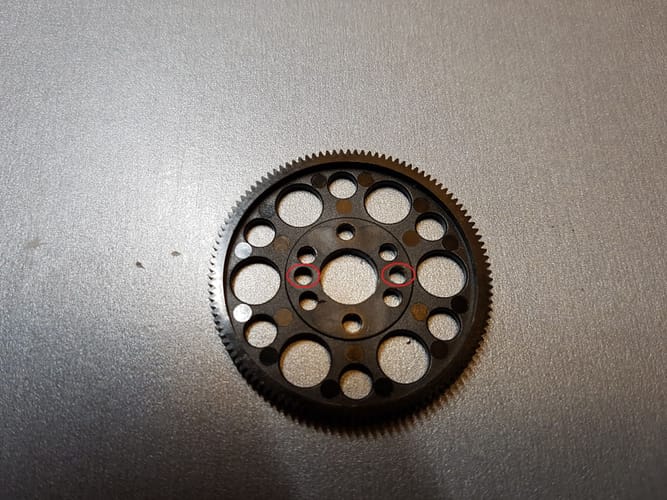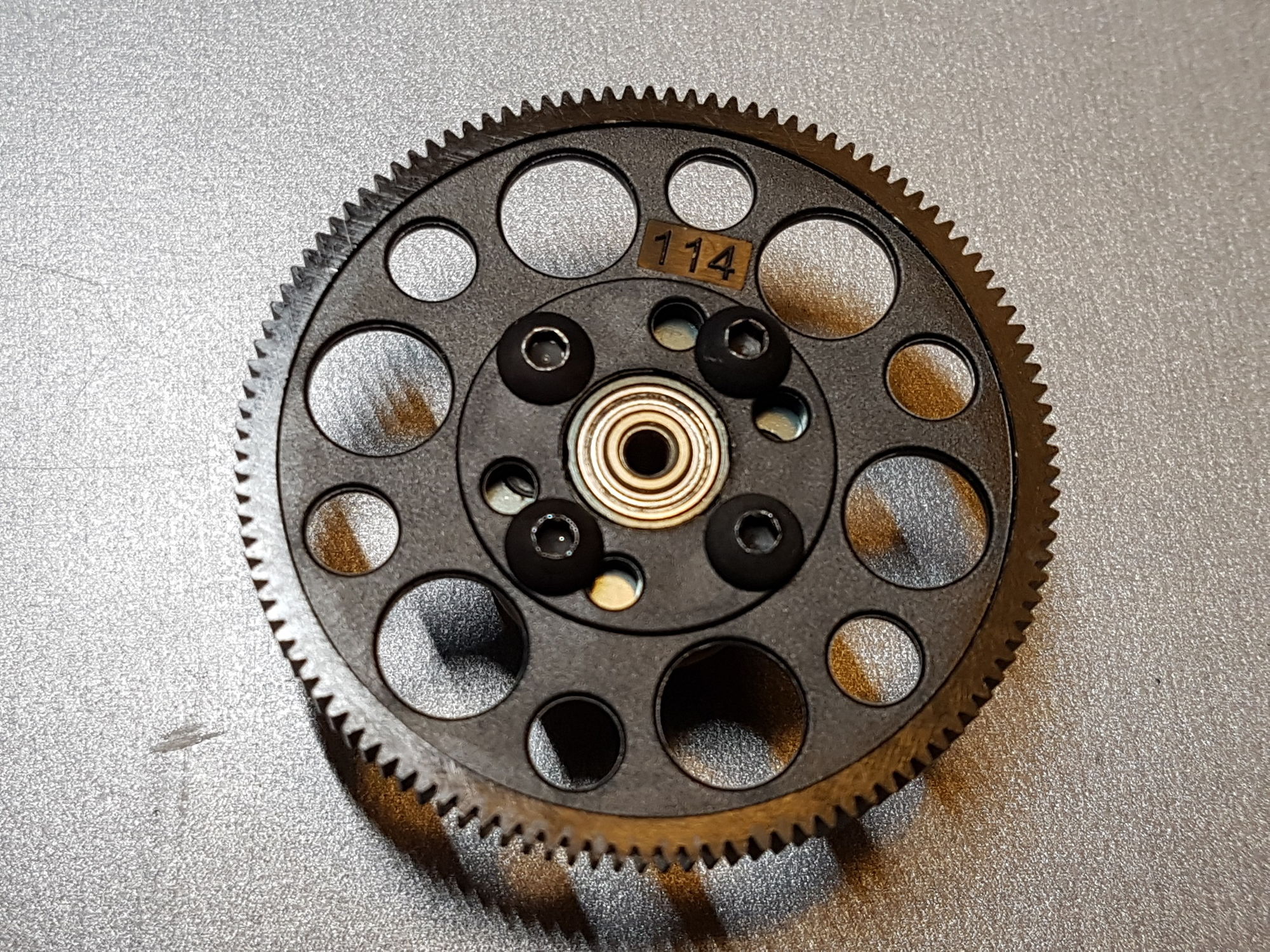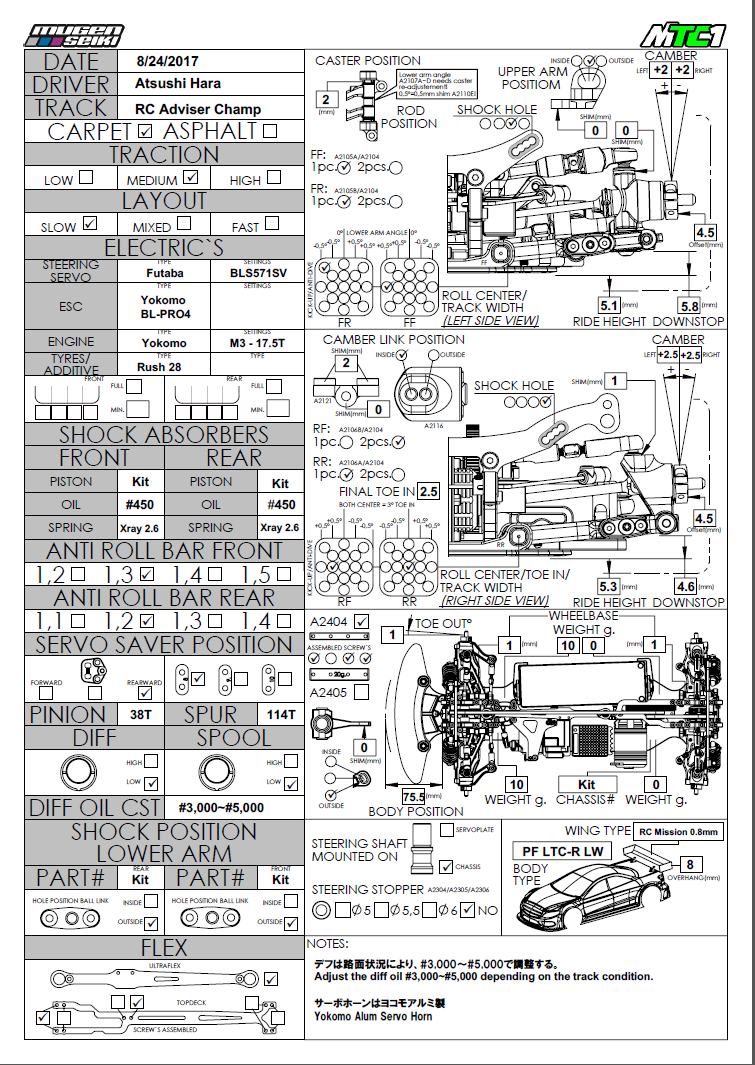Mugen MTC1
|
|||
#346
Tech Initiate
montech racer
#347
The weight itself is however not a problem (we are talking about say 10gram difference or so), but the kinetic momentum is. The difference becomes important when spinning up a 10gr heavier diff from 2000RPM to 6000RPM. I think this will definitely affect acceleration. We will just have to wait and see how much it weighs.
#348
Hard to say. The Losi alloy diff has steel pinions and outdrives and it is a bit heavier than the all plastic versions from various manufacturers, but if you use the steel pinions in the Xray diff for instance the difference is negligible.
The weight itself is however not a problem (we are talking about say 10gram difference or so), but the kinetic momentum is. The difference becomes important when spinning up a 10gr heavier diff from 2000RPM to 6000RPM. I think this will definitely affect acceleration. We will just have to wait and see how much it weighs.
The weight itself is however not a problem (we are talking about say 10gram difference or so), but the kinetic momentum is. The difference becomes important when spinning up a 10gr heavier diff from 2000RPM to 6000RPM. I think this will definitely affect acceleration. We will just have to wait and see how much it weighs.
Anyways its run at this past ets showed it was not slow on acceleration. Probably so minut of effect you wont even notice.
#349

Xray's gear diff is lighter than the ball diff it replaced by around 10g if I recall.
Definitely interested to see the Mugen's alloy diff.
#350
On my current car for stock 17.5, i changed my front out drives from steel to aluminum which took 7 grams off. Didnt noticed a difference in performance.
Every car has one or two things that may weight more or just that one person might not like on the car.
Every car has one or two things that may weight more or just that one person might not like on the car.
#351
Awesomatix cars have alloy diffs and "heavy-ish" steel outdrives. I don't think their acceleration is affected much in spec classes. I would think that the design is done so that as much material as is possible was reduced. Alloy can have some benefits, as it will probably dissipate heat better and make the oil stay a little more consitent over a run.
#352
Kinetic momentum of a heavy spinning diff also affects how quickly your car can change direction.
The Losi diff I mentioned above is 33grams. A Schumacher diff (Mi6EVo) is 18 grams. The kinetic momentum at 6000RPM (top RPM for cars in stock on our track) is about .09kg*m for the Schuie versus 0.16 for the Losi. (1kg*m is like spinning a brick with mass 1kg on a rope 1m long at 1RPM).
Now try this. Take the wheels off your car, hold it in the air, horizontal. Run it at 6-7k RPM in the air. Now turn the car left or right in the air. Try to do it quickly as if you were racing and going around corners (a few fractions of a second). Feel the resistance? That's the kinetic momentum of the diffs opposing you.
Repeat the experiment with the other diff of choice and compare.
That's the extra work your tires will have to do (if they have the grip, that is).
The extra work the tires have to do requires either extra time or extra power or both to achieve it.
Last edited by niznai; 07-31-2017 at 07:30 AM.
#353
Just gimme my Mugen.
#354
Yeah, I would be inclined to say that with an alloy housing, you could run the plastic pinions without shims. I don't see friction in the bevel cluster as a concern - the drag exerted by the oil is way higher than whatever difference you might see between plastic and steel gears. That is of course assuming you have some play in the gear mesh (i.e. you're not grinding the bejesus out of them).
Kinetic momentum of a heavy spinning diff also affects how quickly your car can change direction.
The Losi diff I mentioned above is 33grams. A Schumacher diff (Mi6EVo) is 18 grams. The kinetic momentum at 6000RPM (top RPM for cars in stock on our track) is about .09kg*m for the Schuie versus 0.16 for the Losi. (1kg*m is like spinning a brick with mass 1kg on a rope 1m long at 1RPM).
Now try this. Take the wheels off your car, hold it in the air, horizontal. Run it at 6-7k RPM in the air. Now turn the car left or right in the air. Try to do it quickly as if you were racing and going around corners (a few fractions of a second). Feel the resistance? That's the kinetic momentum of the diffs opposing you.
Repeat the experiment with the other diff of choice and compare.
That's the extra work your tires will have to do (if they have the grip, that is).
The extra work the tires have to do requires either extra time or extra power or both to achieve it.
Kinetic momentum of a heavy spinning diff also affects how quickly your car can change direction.
The Losi diff I mentioned above is 33grams. A Schumacher diff (Mi6EVo) is 18 grams. The kinetic momentum at 6000RPM (top RPM for cars in stock on our track) is about .09kg*m for the Schuie versus 0.16 for the Losi. (1kg*m is like spinning a brick with mass 1kg on a rope 1m long at 1RPM).
Now try this. Take the wheels off your car, hold it in the air, horizontal. Run it at 6-7k RPM in the air. Now turn the car left or right in the air. Try to do it quickly as if you were racing and going around corners (a few fractions of a second). Feel the resistance? That's the kinetic momentum of the diffs opposing you.
Repeat the experiment with the other diff of choice and compare.
That's the extra work your tires will have to do (if they have the grip, that is).
The extra work the tires have to do requires either extra time or extra power or both to achieve it.

#355
Yeah, I would be inclined to say that with an alloy housing, you could run the plastic pinions without shims. I don't see friction in the bevel cluster as a concern - the drag exerted by the oil is way higher than whatever difference you might see between plastic and steel gears. That is of course assuming you have some play in the gear mesh (i.e. you're not grinding the bejesus out of them).
Kinetic momentum of a heavy spinning diff also affects how quickly your car can change direction.
The Losi diff I mentioned above is 33grams. A Schumacher diff (Mi6EVo) is 18 grams. The kinetic momentum at 6000RPM (top RPM for cars in stock on our track) is about .09kg*m for the Schuie versus 0.16 for the Losi. (1kg*m is like spinning a brick with mass 1kg on a rope 1m long at 1RPM).
Now try this. Take the wheels off your car, hold it in the air, horizontal. Run it at 6-7k RPM in the air. Now turn the car left or right in the air. Try to do it quickly as if you were racing and going around corners (a few fractions of a second). Feel the resistance? That's the kinetic momentum of the diffs opposing you.
Repeat the experiment with the other diff of choice and compare.
That's the extra work your tires will have to do (if they have the grip, that is).
The extra work the tires have to do requires either extra time or extra power or both to achieve it.
Kinetic momentum of a heavy spinning diff also affects how quickly your car can change direction.
The Losi diff I mentioned above is 33grams. A Schumacher diff (Mi6EVo) is 18 grams. The kinetic momentum at 6000RPM (top RPM for cars in stock on our track) is about .09kg*m for the Schuie versus 0.16 for the Losi. (1kg*m is like spinning a brick with mass 1kg on a rope 1m long at 1RPM).
Now try this. Take the wheels off your car, hold it in the air, horizontal. Run it at 6-7k RPM in the air. Now turn the car left or right in the air. Try to do it quickly as if you were racing and going around corners (a few fractions of a second). Feel the resistance? That's the kinetic momentum of the diffs opposing you.
Repeat the experiment with the other diff of choice and compare.
That's the extra work your tires will have to do (if they have the grip, that is).
The extra work the tires have to do requires either extra time or extra power or both to achieve it.
Also running as dry as possible with low diff case air pressure(for bevel geared cars) is also important to maximize output power....
#356
Kinetic momentum is real (as in you can actually calculate it, and if you run that test, you might even get a feel for its magnitude). Whether it affects YOUR lap times, on YOUR track, well, that's another story.
There are too many factors that may offset it or make it irrelevant.
Whatever the case, it's not a bad idea to keep it to a minimum if you don't have to compromise too much elsewhere.
#357
Tech Rookie
So what is the suspected timeline for this car? Are we expecting to see an alloy chassis for it heading into carpet season or are we still to early in the design cycle to be seeing that sort of thing?
#358
Alloy chassis is already designed - can see it in the parts list from Mugen website. Car should be shipping like today but that isn't confirmed.
#359
It is not important if you notice it or not. I mentioned many things I can not notice, and you can't theoretically calculate them, and there was no compelling argument presented ever to prove such effects exist.
Kinetic momentum is real (as in you can actually calculate it, and if you run that test, you might even get a feel for its magnitude). Whether it affects YOUR lap times, on YOUR track, well, that's another story.
There are too many factors that may offset it or make it irrelevant.
Whatever the case, it's not a bad idea to keep it to a minimum if you don't have to compromise too much elsewhere.
Kinetic momentum is real (as in you can actually calculate it, and if you run that test, you might even get a feel for its magnitude). Whether it affects YOUR lap times, on YOUR track, well, that's another story.
There are too many factors that may offset it or make it irrelevant.
Whatever the case, it's not a bad idea to keep it to a minimum if you don't have to compromise too much elsewhere.
I once built a car that had these perfectly machined front driveshafts - super free but no play at all. But because they weren't the constant velocity type, the differences in rotational velocity caused an unbelievable vibration - it was so bad that the suspension would compress in mid air when the wheels turned. You had to see it to believe it. Add a little a free play to it and the problem was gone. Anyway, this Mugen diff should run super true and smooth with no wobbly bits and very low drag. I think the extra mass will be worth it.
#360
One point about my comments above. I was actually expecting someone to point this out.
My calculations assume the entire mass of the diff is at the outer diameter of the diff. The diff is small enough, but this is not a realistic assumption. Kinetic momentum depends heavily on the radius (radius is squared). You can see this in flywheel design where engineers replace a heavy flywheel with a small radius by a very light one with a large radius. Both have the same kinetic momentum.
In our diffs the outdrives (and bearings) are very small in diameter compared to the diff case. That means their weight will contribute little to the kinetic momentum compared to some small weight placed on the circumference of the case. Such as an Aluminium case for instance.
And just a personal preference, given the small impact of mass at small radius, I prefer brass/graphite bronze bushings instead of bearings, simply because bushings can be machined closer to tolerance (I can actually turn my own) even though brass or bronze are heavier than steel. Being so small however it barely makes any difference in weight and friction is a non issue.
In fact, I suspect a good graphite bronze bushing is going to be better with friction given that the available bearings in that size are usually crap and adding lubrication will just make them drag more. Even a good bearing in that size (which would be expensive) will be a pain given the minute contact surface area and the relatively crap quality steel they are made of. Add a tiny bit of side loading to compress the o-ring seals or imagine a shunt on the side and you most likely pinched it and damaged the balls, the races or both. Too much trouble. A good graphite bronze bushing offers a large contact area and you can basically run it dry forever. You can also side load it as much as you want with no problems.
My calculations assume the entire mass of the diff is at the outer diameter of the diff. The diff is small enough, but this is not a realistic assumption. Kinetic momentum depends heavily on the radius (radius is squared). You can see this in flywheel design where engineers replace a heavy flywheel with a small radius by a very light one with a large radius. Both have the same kinetic momentum.
In our diffs the outdrives (and bearings) are very small in diameter compared to the diff case. That means their weight will contribute little to the kinetic momentum compared to some small weight placed on the circumference of the case. Such as an Aluminium case for instance.
And just a personal preference, given the small impact of mass at small radius, I prefer brass/graphite bronze bushings instead of bearings, simply because bushings can be machined closer to tolerance (I can actually turn my own) even though brass or bronze are heavier than steel. Being so small however it barely makes any difference in weight and friction is a non issue.
In fact, I suspect a good graphite bronze bushing is going to be better with friction given that the available bearings in that size are usually crap and adding lubrication will just make them drag more. Even a good bearing in that size (which would be expensive) will be a pain given the minute contact surface area and the relatively crap quality steel they are made of. Add a tiny bit of side loading to compress the o-ring seals or imagine a shunt on the side and you most likely pinched it and damaged the balls, the races or both. Too much trouble. A good graphite bronze bushing offers a large contact area and you can basically run it dry forever. You can also side load it as much as you want with no problems.
Last edited by niznai; 07-31-2017 at 08:56 PM.



 759Likes
759Likes

